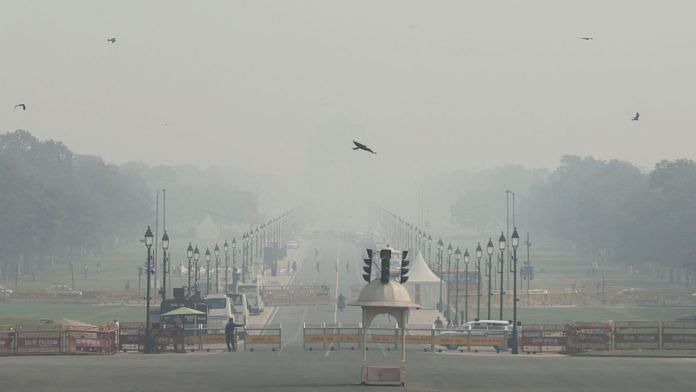New Delhi: The Delhi government has decided to bring back the odd-even scheme to combat the severe pollution levels in the capital. Under this scheme, cars with registration numbers ending with odd and even digits are allowed to ply on alternate days.
Delhi Environment Minister Gopal Rai said Monday that this would happen between 13 and 20 November, since authorities expect air pollution levels to rise after Diwali, despite the ban on the use of firecrackers in the capital.
Speaking to the media after a high-level meeting called by Chief Minister Arvind Kejriwal, Rai said the government was anticipating a rise in pollution after Diwali (12 November).
“Firecrackers are not allowed in Delhi. Yet, they were burst in previous years. The police have been asked to crack down on this. We also urge the BJP governments in Uttar Pradesh and Haryana to stop the bursting of crackers… We have decided to bring back the odd-even scheme after Diwali. Number plates ending with 1, 3, 5, 7 and 9 will be allowed on odd days and those with 0, 2, 4, 6 and 8 on even days,” Rai said, detailing the several measures adopted in the meeting Monday.
Incidentally, the odd-even rule has been the Aam Aadmi Party (AAP) government’s primary weapon to combat pollution in the capital.
Rai also said schools would be shut till 10 November for all students except for those who were in classes 10 and 12. At present, classes for the primary section have been suspended.
A toxic haze sat heavy on Delhi and the national capital region (NCR) for four days in a row, Monday, as pollution levels remained at seven or eight times above the prescribed limit.
On Sunday, Delhi’s air quality was declared as “severe plus” – for the second time in three days – prompting the government to enforce strict curbs, including banning the entry of polluting trucks.
The air pollution was exacerbated by unfavourable wind conditions and a sharp rise in farm fires across northern India.
According to the Delhi-based Indian Agricultural Research Institute (IARI), a total of 4,160 farm fires were reported from northern India, Sunday, the highest so far this season.
Punjab alone reported 3,230 incidents of stubble burning, the state’s highest in a day so far this season, according to Punjab Remote Sensing Centre (PRSC) data, news agency PTI reported.
The 24-hour average Air Quality Index (AQI), recorded at 4 pm every day, worsened from 415 (Saturday) to 454 (Sunday), bringing into force all emergency measures mandated under the final Stage-IV of the central government’s Graded Response Action Plan (GRAP).
Under Stage-IV of GRAP, only CNG, electric, and BS VI-compliant vehicles from other states will now be allowed to enter Delhi, with exemptions granted to only those employed for essential services. The ban will also apply to all medium and heavy goods vehicles not engaged in essential services, the CAQM said in an order.
#WATCH | Delhi Environment Minister Gopal Rai says,"…The ban that was imposed on BS-III petrol vehicles and BS-IV diesel vehicles will be continued in GRAP-4… Except for LNG, CNG and electric trucks of the essential commodities and essential service vehicles, other trucks… pic.twitter.com/DfDsZNWx9D
— ANI (@ANI) November 6, 2023
The CAQM, or Commission for Air Quality Management, is a statutory body responsible for formulating strategies to combat pollution in the region.
Delhi’s AQI stood at 440 at 7 am, Monday. Several cities in neighbouring Haryana, Rajasthan, and Uttar Pradesh also reported hazardous air quality – Ghaziabad (413), Gurugram (369), Noida (403), Greater Noida (396) and Faridabad (426).
The India Meteorological Department (IMD) has said that conditions favourable for the dispersion of pollutants were likely to develop Tuesday night onwards under the influence of an upcoming western disturbance.
The concentration of PM2.5, or fine particulate matter capable of penetrating deep into the respiratory system and triggering health problems, has exceeded the government-prescribed safe limit of 60 micrograms per cubic metre by seven to eight times at multiple locations throughout Delhi-NCR.
This is 30 to 40 times the healthy limit of 15 micrograms per cubic metre set by the WHO.
Apart from primary schools being shut, and government employees urged to work online, there is also a ban on construction work related to linear public projects.
Delhi’s air quality ranks among the worst in the world’s capital cities. According to the Delhi Pollution Control Committee (DPCC), the capital experiences peak pollution from November 1 to November 15 when the number of stubble-burning incidents in Punjab and Haryana increase.
Also read: Severe or worse air quality in Delhi for 4th day on trot



